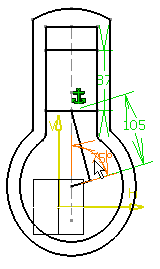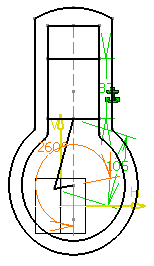Select the angle constraint as shown:

Click Animate Constraints
 .
The Animate Constraint dialog box appears. The First
value and Last value fields let you define the maximum
and minimum values for the constraint. The Number of steps
field defines the number of values you wish to assign to the constraint
between the first and last values.
.
The Animate Constraint dialog box appears. The First
value and Last value fields let you define the maximum
and minimum values for the constraint. The Number of steps
field defines the number of values you wish to assign to the constraint
between the first and last values.
Type 15 as Number of steps
Type 115deg for the First value
Type 260deg for the Last value.
Select Hide constraints for hiding constraints.
This can be useful when there are many elements in the sketch.
Select Loop
Select Run Animation
 to see how the
sketch is affected by the different values assigned to the constraint.
The command induces a clockwise rotation while moving the rectangle
up and down. These three pictures below give examples of this behavior.
to see how the
sketch is affected by the different values assigned to the constraint.
The command induces a clockwise rotation while moving the rectangle
up and down. These three pictures below give examples of this behavior.
Clear Hide constraints option to display
the constraints again.
Once the maximum value is reached, that is 260 degrees, the sketch looks
like this:
